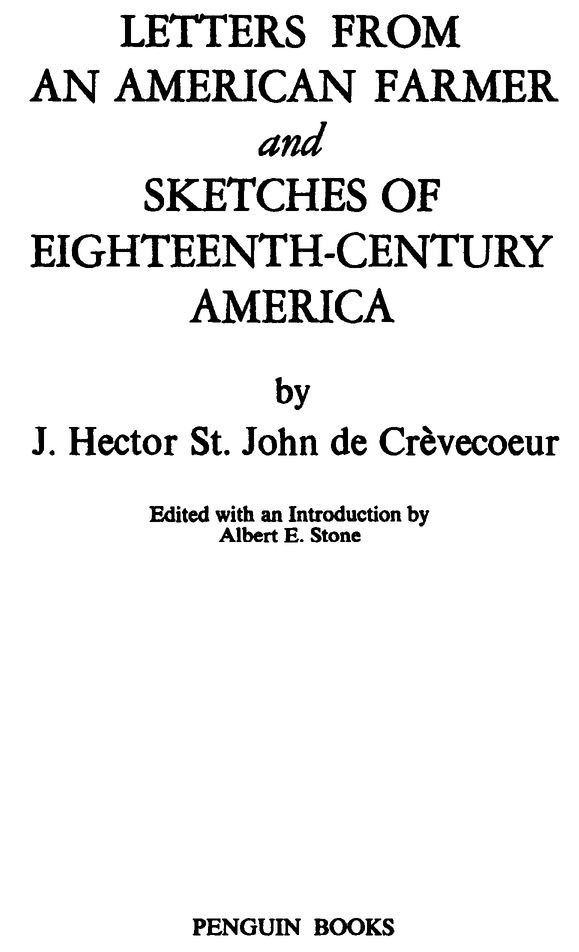Table of Contents
PENGUIN

CLASSICS
LETTERS FROM AN AMERICAN FARMER and SKETCHES OF EIGHTEENTH-CENTURY AMERICA
Michel-Guillaume Saint-Jean de Crvecoeur was born at Caen, France, on January 31, 1735, into an ancient but unaffluent branch of the Norman gentry. He received a sound classical education in Latin, rhetoric, mathematics, and theology from the Jesuits at the College de Mont. In 1755 Crvecoeur sailed for New France and a cadetship in the French colonial army. He distinguished himself as an artillery officer during the French and Indian War and fought under Montcalm at the siege of Quebec. After the war, Crvecoeur emigrated to the English colony of New York, changing his name to J. Hector St. John. In 1769 he was married to Mehetable Tippett, a member of a prosperous Tory family, and settled at Pine Hill, a 250-acre farm in Orange County, New York. The Edenic years at Pine Hill were shattered by the American Revolution, when Crvecoeur-suspected by his Patriot neighbors of harboring monarchist sympathieswas persecuted, unjustly imprisoned, and forced to flee the colonies. The publication of his Letters from an American Farmer in 1781 was an instant success in Europe, and Crvecoeurlionized in the Parisian salons as well as in the court of Versailleswas awarded a consulship to the newly formed American republic. As consul, Crvecoeur served as a political and cultural liaison between France and the United States; helped to organize and promote trade across the Atlantic; and corresponded with many of the greatest figures of the Enlightenment, including Franklin, Jefferson, and Madison. He died in Sarcelles, France, on November 12, 1813.
Albert E. Stone is Professor of English and Chairman of the American Studies Program at the University of Iowa. He is the author of The Innocent Eye: Childhood in Mark Twains Imagination and the editor of The American Autobiography: A Collection of Critical Essays and Twentieth-Century Interpretations of James The Ambassadors.
Introduction
American literature, as the voice of our national consciousness, begins in 1782 with the first publication in England of Letters from an American Farmer. Literature, that is, considered as arrangements of affective images embodied in the traditional forms of poetry, fiction, and drama, and expressing the spirit of place. Before 1782, a good many histories, travel accounts, psalmbooks, sermons, elegies, memoirs, and autobiographies (spiritual and otherwise) had been written in the colonies. Certain of these worksBenjamin Franklins Autobiography is a notable and obvious examplecould scarcely have been composed elsewhere or by members of another society. Just as Franklin is the first representative American, of the national period at least, his book seems also to bear unmistakably the stamp of this locale; it is an American artifact. Yet, as D. H. Lawrence has reminded us, Crvecoeur deserves recognition as a literary Founding Father, too. Franklin is the real practical prototype of the American, he observed in Studies in Classic American Literature. Crvecoeur is the emotional. To the European, the American is first and foremost a dollar-fiend. We tend to forget the emotional heritage of Hector St. John de Crvecoeur.
If Americans long neglected this heritage, it was Europeans like Lawrence who kept it alive. This has been true almost from the beginning. In the half century after 1782, Letters from an American Farmer enjoyed only a moderate fame in the United States but in Europe went into edition after edition, appearing successively in London, Dublin, Belfast, Leipzig, Leyden, Paris, and Maastricht. Translated into French, Dutch, and German, it provided two generations of Europeans with their chief impressions of the American colonies. The book was, of course, tailor-made for the Romantic imagination. Followers of Cole-ridge and Rousseau embraced it enthusiastically; physiocrat and pantisocratist alike were affected by a book offering the verifiable account (as they felt) of a transatlantic utopia under the wigwams. But with the advent of a more rationalistic age Crvecoeur went into eclipse. By the 1830s and 1840s, Americans, though in the heyday of their Romantic period, were in no mood to appreciate Crvecoeurs cosmopolitan and Anglophilic biases, and Europeans adopted newer and sharper images of America. The detached cultural analysis of de Tocqueville and the jaundiced social critiques of Mrs. Trollope and Dickens made the Letters sound old-fashioned and nave. The eclipse lasted until the turn of the twentieth century, when Americans recovered their colonial past along with its architecture, the paintings of John Singleton Copley (another Anglophile), and the writings of Jefferson. Since then, three or four generations of Americansthat of Moses Colt Tyler, the late nineteenth-century literary historian, Vernon Parrington, the intellectual historian of the 1920s, and our ownhave read Crvecoeur with increasing interest and respect. Each finds something fresh and relevant in the book. Recent events teach both the American-ness and the European-ness of our culture; today, both Frederick Jackson Turners frontier hypothesis and Oscar Handlins histories of immigration are read with respect. Post-World War II generations, trained by the New Criticism and American Studies to respect the text and its cultural determinants, recognize Crvecoeurs specificallv literary qualities as earlier readers did not always do. Moreover, the opposing forces animating his life and thoughtreason and emotion, nature and Nature, the real and the ideal, Enlightenment and Romanticism, Europe and the New World, civilization and the wilderness, aristocracy and democracy, revolution and social orderspeak forcibly to modern readers schooled to consider complexity, tension, and ambiguity the proper marks of modern literary art. The present age, whose spokesman on these matters had been Marius Bewley, reads Letters from an American Farmer as a powerful document at once literary, freshly contemporary, and characteristically American.
What, then, is the American, this new man? Crevecoeur was the first to ask. A necessary way to understand Letters and Sketches as the partly autobiographical replies to his own question is to twist it around and inquire: What is this new man, the American writer?
He is, first of all, a man of aliases and disguisesJames, the American farmer of Pennsylvania. The reader speedily suspects that character and creator are two separate individuals. It helps to be aware of their very different histories. Though James speaks of a family farm inherited from his father, the actual author of the Letters was, like many colonists in the eighteenth century, an immigrant. But the twenty-four-year-old adventurer who arrived in New York in 1759 was no common European peasant or artisan. Michel-Guillaume-Jean de Crvecoeur was born at Caen on January 31, 1735, into an ancient but unaffluent branch of the Norman gentry. By no means an untutored countryman, he received a sound classical schooling from the Jesuits at the College du Mont, in Latin, rhetoric, mathematics, and theology (against which, in good deistic fashion, he soon rebelled). In 1754 he paid an extended visit to distant British relatives at Salisbury, where he met and became engaged to a merchants daughter. She died before the marriage could take place. From these years dates the admiration for England and English culture that animates his books.


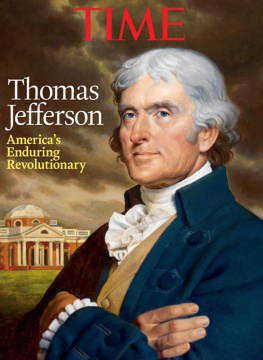

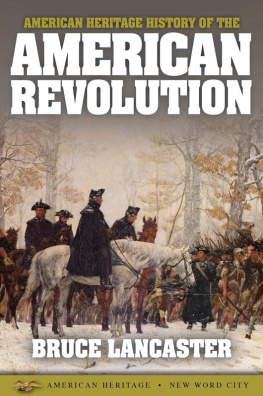
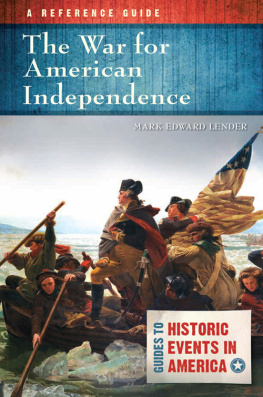
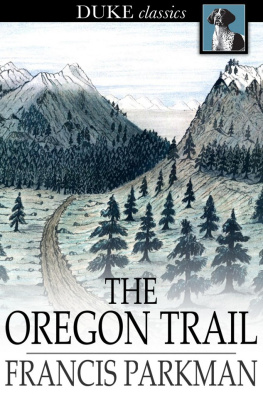
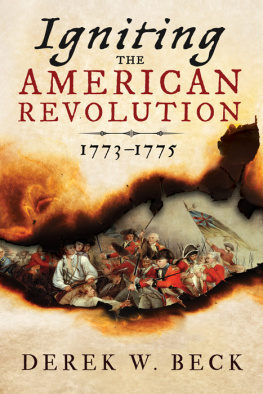
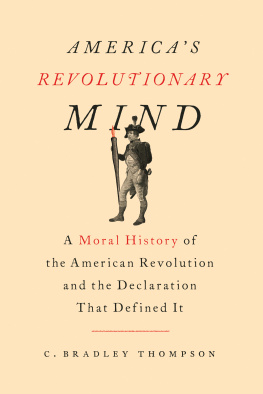

 CLASSICS
CLASSICS